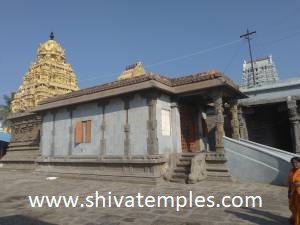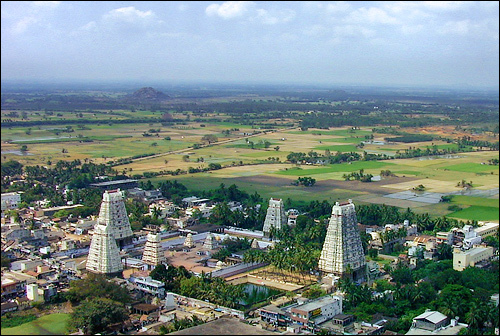Tirukazhukkundram is recognized as one of the 44 Paadal Petra Shivasthalams, where revered saints Tirugyanasambandhar, Tirunavukkarasar, and Sundarar have composed hymns in honor of the deity. The site is believed to be named Vedhagiri due to the sacred Vedas manifesting as mountains in this location. Additionally, Tirukazhukundram is referred to by various names, including Vedhachalam, Kathalivanam, and Kazhukkundram. The area features two Shiva temples: one located on a hilltop, known as Tirumalai, and the other in the town of Tirukazhukundram, called Thazhakoil. The principal deity of the hill temple is Vedhapureeswarar, while Bhakthavathsaleswarar presides over the town temple. According to local tradition, the four Vedas—Rik, Yajur, Sama, and Atharvana—are said to have transformed into large rock formations, with Vedhapureeswarar residing atop the hill associated with the Atharvana Veda.
The temple hill, encircled by a perimeter of roughly 4 kilometers, rises to an elevation of 500 feet. At its summit lies a temple featuring a single prakaram and an impressive Rajagopuram. Access to the temple is facilitated by well-constructed steps leading up the hill. The principal deity Vedhapureeswarar is a 'Swayambhu Linga' resembling a banana flower and the female deity Chokka Nayaki is also known as Pennin-nallall ammai. This revered site, known as Kazhukkundram, derives its name from the belief that eagles, or Kazhugu in Tamil, have venerated the deity here in pursuit of salvation. Over the four yugas, various pairs of eagles have worshipped at this location, achieving liberation, including Shandan and Prashandan in the first yuga, Shambathi and Jatayu in the second, Shampuguththan and Maguththan in the third, and Shambu and Adi in the fourth. Notably, until recently, two eagles would visit the temple at noon to partake in feeding.
One way to descend from the mountain temple is by following the steps that lead downward. Alternatively, for those inclined to explore, another route is available. This path leads to a notable cave temple from the Pallava Mahendravarman era, dating between 610 AD and 640 AD, which houses a Shiva Linga.
Thazhakoil - The temple, situated at the base of the hill, spans an impressive 12 acres and features four gopurams along with three concentric prakarams. Dominating the eastern side is the rajagopuram, a seven-tiered structure that serves as the primary entrance. This gateway opens into a four-pillared hall, adjacent to which is another mandap that functions as the temple's administrative office, prominently displaying a striking sculpture of Durga with eight arms on its stone wall. To the left of the four-pillared hall lies an additional mandap, embellished with 16 intricately carved pillars showcasing exquisite sculptures. Continuing past the four-pillared hall, one encounters another gopuram, flanked by statues of Vinayaka and Subramanya. As one proceeds along the outer prakaram in a clockwise manner, 'Nandi theertham' is located on the northern side, featuring a nandi statue elegantly positioned by its bank.
The second gopuram serves as a link between the outer and inner prakaram, which contains sannidhis for various deities, including Athmanathar, Manikkavasakar, Ekambaranathar, Vanduvana Vinayaka, Jambukeshwarar, Arunalachaleshwarar, Arumukha, and the female deity Thripurasundari, whose sannidhi has a mandap in the front. Surrounding the sannidhi of Goddess Thripurasundari is a pathway designed for the ritual of 'pradakshina', circumambulation. The goddess is depicted in a standing posture, oriented towards the east, and the ritual of 'Abishekam' is exclusively performed on her feet. Notably, on three significant occasions—Aadi Pooram, the ninth day of Navarathri, and the night of Panguni Uthiram—the entire form of the Goddess is anointed with sacred offerings, enhancing the sanctity of these events.
Adjacent to the sannidhi of Thripurasundari lies the Prathyaksha Vedhagireeshwar sannidhi. Following this is the Nataraja Sabha. Upon completing the circumambulation of the second prakaram at the wooden dwajasthambam and offering prayers to Akora Veerabadrar and the Dwarapalakas, we proceed to the innermost prakaram which houses sannidhis for Surya, Vinayaka, the 63 nayanmars and seven Shiva Lingas, all aligned in a row. The principal deity, Bhakthavathsaleshwarar, is situated on a square Avudayar facing east. The goshta images feature Vinayaka, Dakshinamurthy, Lingothbhava, Brahma, and Goddess Durga, while there are dedicated sannidhis for Bhairavar and Chandikeshwarar.
At the end of the road along the eastern entrance lies the famous pond known as 'Shangu Theertham'. This sacred water body is notable for a unique occurrence: every 12 years, a new conch shell rises from its depths. These conches are meticulously gathered and housed within the temple. According to legend, when Markandeyar was without a vessel to conduct rituals for the deity, God appeared to him and gifted him a conch. Since that time, it is believed that a new conch is born in the pond every 12 years. It is widely held that bathing in the pond at dawn and practicing 'giri valam'—the circumambulation of the hill—can provide comfort and healing from various ailments.
 Tirukazhukkundram
Tirukazhukkundram Tirumalai View
Tirumalai View Prakaram
Prakaram 16 pillared hall
16 pillared hall Eastern Gopuram
Eastern Gopuram Bird's eye view
Bird's eye view Shangu Theertham
Shangu Theertham